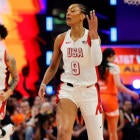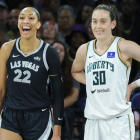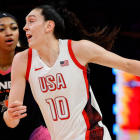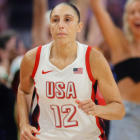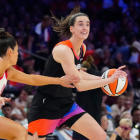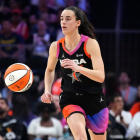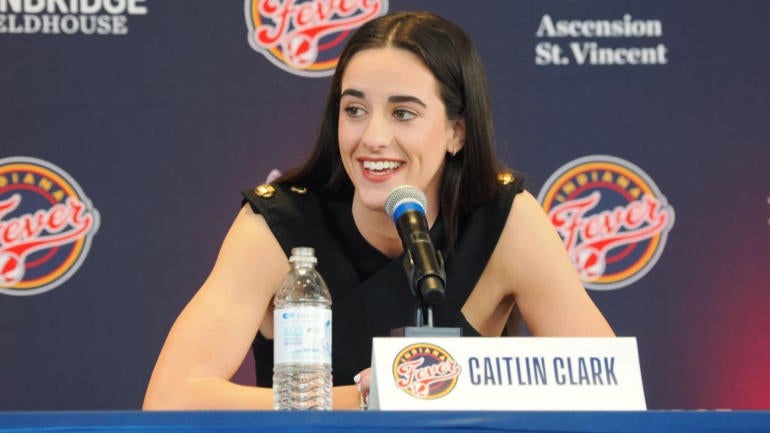
Women's basketball is undeniably on the rise, and WNBA rookies Caitlin Clark and Angel Reese are among the sport's most recognizable names.
For the first time, the NCAA Women's Tournament saw record viewership, and the championship game between Iowa and South Carolina outdrew the men's championship game. For a second year in a row, Clark and Reese battled in one of the most-viewed NCAA women's basketball games in history.
Now, stars like Clark, Reese and the rest of the 2024 rookie class are aiming to help grow the WNBA as they helped grow college basketball.
What's at stake for the WNBA?
Simply put, the WNBA is looking for financial viability, or as WNBA commissioner Cathy Engelbert put it on draft night, a business transformation.
On the whole, the league has seen transformation under Engelbert. The WNBA completed a $75 million capital raise in 2022 and continues to add sponsors or WNBA Changemakers to their lineup. The 2023 league impact report shows WNBA full season viewership is up 21% and Finals viewership is up 36% year-over-year. Additionally, nationally-televised games increased 39% from 2022 to 2023.
However, none of these gains have led to what players say they want the most: increased salaries, improved travel and overall expansion. The latter is in the works, as the Bay Area was awarded an expansion team in October. Additionally, Engelbert is anticipating the league will have 16 teams by the 2028 season.
That projections has been on track for some time, but can the 2024 rookie class positively impact the league's growth timeline?
Likely, yes. And it begins with reach.
Although many, including South Carolina coach Dawn Staley, are referring to this surge in women's basketball the "Caitlin Clark effect," the numbers show Clark is one of several potential sports superstars.
To begin, Reese and her LSU teammate, Flau'jae Johnson, who also played in the Elite Eight game that drew 12.3 million viewers, lead NIL athletes among the highest follower growth, per SponsorUnited. Additionally, Reese, former Stanford star Cameron Brink and Johnson all outperformed Clark in number of NIL deals.
3 of the top 5 female athletes with the most NIL deals are basketball players @Reese10Angel, @cameronbrink22, & @Flaujae.🏀
— SponsorUnited (@sponsorunited) March 22, 2024
With #MarchMadness in action, see the brands behind the players—like @DICKS & @Buick—plus more insights ➡️https://t.co/zmocMxLcD9 #CollegeBasketball pic.twitter.com/cpEmAEcyEr
Rookies under pressure
The incoming rookies know they have an unprecedented audience, and the pressure that comes with it, as they embark on their first professional training camps.
"I certainly know there's pressure there," Clark said during her Indiana Fever introductory press conference. "That's been my entire career."
However, Clark's main focus is being a good teammate and a good WNBA player.
"I know this a team sport, it's not all about me, it's not everything I have to do," she said. "When I've been able to understand that, that's allowed me to play my best. I think it's just using your resources, asking questions, knowing not everything is going to be perfect and giving myself a little grace."
Chicago Sky rookie Kamilla Cardoso says she doesn't feel any pressure, and instead feels excitement.
"I think we made a history, we brought more viewers to the women's game," she said during her introductory press conference. "Being able to bring all of all of our college fans to watch the WNBA is a great thing."
With Reese, Clark and Brink all now WNBA draftees, many are expecting their crossover appeal to carryover into their professional careers. Its already spanned to Vogue Magazine, Saturday Night Live and Estée Lauder, respectively, just to name a few.
But is it sustainable? Early returns suggest it could be.
The 2024 WNBA Draft was the most-watched in league history. The broadcast averaged 2.45 million viewers and peaked at 3.09 million, a 307% increase from the 2004 draft, where Diana Taurasi was selected first overall by the Phoenix Mercury.
Clark's Indiana jersey sold out on the Fanatics website in 60 minutes. The Chicago Sky social media accounts reportedly averaged 5,000 likes every five minutes on draft night. And WNBA ticket sales are up across the league, with teams like the Dallas Wings and Atlanta Dream selling out season tickets within the last week. The Las Vegas Aces reported their season tickets sold out in March.
The incoming rookie class represents a cultural change in women's basketball. However, they are the tip of the iceberg, the visible and undeniable shift. While the 2024 draft class has certainly moved the needle, we'd be remiss to overlook the undeniable growth the WNBA has seen since the 2020 season.
The 2023 WNBA Finals featuring the Aces and the New York Liberty was the most-watched Finals in league history and up 36% from 2022. The fourth and final game drew 889,000 viewers and peaked at 1.3 million viewers, the most-watched Game 4 in league history
Additionally, last year's regular season was the most-watched in 21 seasons. The full season (regular season, playoffs and Finals) averaged 453,900 viewers, up 10% from 2022. The 2023 WNBA All-Star Game reached 850,000 viewers and peaked at nearly 1 million viewers.
Will we see WNBA viewership break into the millions in 2024?
Two-time WNBA Champion and league MVP A'ja Wilson certainly hopes so. "I think that sometimes we see a drop off because it's just a trend," Wilson told CBS Sports at a Nike event in Paris. The 2023 WNBA Finals MVP hopes the rise in viewership will follow the rookie class throughout their professional careers.
Part of that is making room for more than one star, says New York Liberty forward Breanna Stewart.
"I feel like people have this want to only have one person have success," Stewart said during the Team USA Media Summit on April 17. " ... This sport is so huge that we can all continue to grow together. Because on the men's side, I don't think they do that.
"We need to widen our scope a little bit."
With former rivals turned teammates like Cardoso and Reese in Chicago, or Clark and 2023 Rookie of the Year Aliyah Boston in Indiana, the rookie class will likely force the issue of more than one superstar.
And right on time too, as the WNBA appears to be in its superteam era.
Veterans Jewell Loyd, Skylar Diggins-Smith and Nneka Ogwumike have partnered in Seattle. The Phoenix Mercury added Natasha Cloud and Kahleah Copper to their core of Diana Taurasi and Brittney Griner. Additionally, teams like the Aces and the Storm will continue to attract top free agents as the only two WNBA teams with their own dedicated training facilities.
Our new home 💚⛈️ pic.twitter.com/DHjRvHFEFR
— Seattle Storm (@seattlestorm) April 18, 2024
Outside of facilities, if the WNBA and its owners want to prepare for the rise in their league, they might also have to consider moving to different home arenas. According to Front Office Sports, the average ticket price sold across the league on Vivid Seats is 129% higher than last year.
However, not all teams can meet this demand in the same way. In 2020, six of the 12 WNBA teams played in facilities that could accommodate at least 10,000 fans, according to Statista.com. Gateway Center Arena, home of the Atlanta Dream, was the most sold-out arena last year. It is also the smallest venue in the league with a maximum capacity of 3,500.
The Wings, who play in the second-smallest arena in the league, reported an overall ticket sales revenue increase of 220%, including a 1,200% increase in individual ticket sales revenue. The team announced this month they hope to move from the College Park Center (maximum capacity of 6,251 people) to the renovated Memorial Auditorium in Downtown Dallas.
"Women's basketball has captured the nation's attention like never before, and both the WNBA and the Wings are experiencing an unprecedented surge in popularity," Wings president and CEO Greg Bibb said in a statement on April 20.
Dallas Memorial Auditorium currently has a maximum capacity of 9,816. As of now, that would place the Wings in the sixth-largest arena in the league.
A new era for the WNBA
All sign point to the rookie class being as successful, if not more, with endorsements and even viewership numbers in the WNBA as they were in college. It is also likely the 2024 WNBA rookie class will amass multiple league titles and individual awards among them.
These projections align with Engelbert's goal of business viability. The 2024 WNBA rookie class might be what the league, and more specifically the Players Association, needs to negotiate higher WNBA salaries and a more comprehensive charter flights system.
Engelbert confirmed the league has expanded its charter program to the tune of a $4 million dollar investment. Charters for all teams in the playoffs and charter for back-to-back games will be available this season, especially due to the condensed schedule for the Olympic break.
"Again, as we build the momentum and build the economic model for fund that longer term -- there's nobody that wants that more than I do for these players -- but we have to be in the right financial position," Engelbert said regarding travel accommodations. "We're not going to jeopardize the financial viability of this league ... but we've been chipping away at it every year."
What gets the league to that viability, Engelbert said, is viewership and media rights deals.
The legacy of the 2024 WNBA rookie class likely lies in if, or when, they can surpass and sustain record viewership and attendance numbers into the millions. This could be the class that helps bring the WNBA valuation to a new level, and with that comes more expansion, more roster spots and better broadcast deals.
"If you build it, they will come," Engelbert said. "We just proved that during the current NCAA March Madness and we will bring that into the WNBA season."
The group most likely to make an undeniable case to help a new media deal to the finish line hasn't even had their first WNBA training camp session yet. But Clark and her colleagues are ready to make even more history.
"The biggest thing we've seen in college is when people gave it an opportunity and actually watched it, they continued to come back for more. And it's the same thing with the WNBA. When you go and buy a ticket or turn on the TV, you see how good it is," Clark said. "That's the biggest thing, and that'll take it to a place a lot of people can't even imagine."
The current WNBA media deal ends in October 2025, two season into the careers of the current rookie class.










